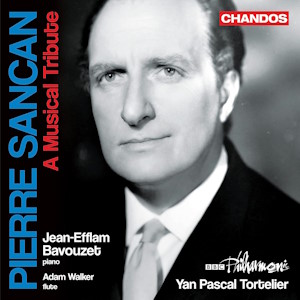
Pierre Sancan (1916-2008)
A Musical Tribute
Jean-Efflam Bavouzet (piano), Adam Walker (flute)
BBC Philharmonic/Yan Pascal Tortelier
rec. 2022, MediaCityUK, Salford, Manchester, UK
Chandos CHAN20154 [73]
The booklet brings us three fascinating essays: by Jean-Efflam-Bavouzet, who was a pupil of Sancan, by Yan Pascal Tortelier, who knew him at the Paris Conservatoire, and the longest by Lionel Esparza. One gets a feeling that Sancan is remembered first as a teacher, next as a concert virtuoso, and only then as a composer. Sancan more or less admitted it himself. He perhaps felt that he had not fully achieved his life ambitions. Yet, when one listens to the Concerto for Piano and orchestra, it is difficult not to think that he was a composer first, and that it was that skill which fed into his teaching and performing, and made him such a charismatic personality.
The nearly thirty-minute concerto’s massive first movement is longer than the other two combined. The work was a showpiece originally for Sancan himself. One is reminded of his love of the Ravel G major Piano Concerto, especially in the dreamy second movement, and the fact that he wrote film scores including, in 1946, the highly successful Les malheurs de Sophie. The language is post-romantic but also quite impulsive and sometimes jazzy and dissonant. It sems that jazz was an influence on Sancan much to his disgrace in the eyes of some of his Conservatoire colleagues. The Allegro vivo / Presto finale recalls Ibert’s Divertissement. It is witty and naughty, with an amusing and surprising ending. It made me very glad to get to meet this composer for the first time.
Equally witty, even brash, is the first number, the uplifting Ouverture joyeuse. Each piece that follows the concerto is short enough to be called a miniature, but each contains a unique world in microcosm. That certainly applies to the virtuosic and showy Toccata for piano internary form, dedicated to Sancan’s parents. Its brilliance outweighs its profundity but it is worth repeated hearing. Perhaps it gives us some idea of Sancan’s own considerable pianistic ability, as does the formidable Mouvement in which Ravel’s harmonic language once again reveals itself, especially in the quieter middle section.
Sancan used two other piano pieces in his own recitals. The Caprice romantique casts a piquant spell; I feel is more romantique than caprice for most of its course. Remarkably, it is just for the left hand. The charming Boite à musique lasts less than two minutes. Both hands are high in the treble clef. The piece describes an old-fashioned music box which gradually winds down. Just as it is about to fizzle out, it is imbued with a new lease of activity.
Whether you consider the three-movement Symphonie for Strings a set of three contrasted miniatures or a short symphony is probably a personal view. Its almost neo-classical energy in the outer movements, its poise in the middle Andante and its humour in the finale make it a real joy. It is compact and holds one’s attention.
One wonders if Sancan had a wider musical vocabulary. The booklet describes Commedia del’arte as a ballet overture. The strings scurry around with much energy, and we have what seem by now obligatory glissandi. He uses them in other works, and must have derived them from Ibert’s Divertissement. The piece is typically witty and never outstays its welcome. So, clearly this is music from the same stable, as it were, but none the worse for that.
I have left the best for last. It is perhaps Sancan’s best known: Sonatine for Flute and Piano. As a flautist of sorts myself, I was delighted to make the acquaintance of this three-movement mostly light-hearted but technically demanding competition piece. It uses a great deal of effective flutter tonguing but is also elegant and lyrical, and – especially in its middle movement – quite Debussian. The Presto finale is exciting and surely taxing, not that Adam Walker had any trouble with its many awkward corners.
As interesting as the booklet essays are, there is very little discussion or analysis of the music itself. That, I feel, is somewhat unfortunate because it is so unfamiliar. The performances are clearly not only affectionately conceived but the playing is wonderful, all in Chandos’s usual outstanding recording quality.
Gary Higginson
Help us financially by purchasing from



Previous review: Nick Barnard (May 2023)
Contents
Overture joyeuse (date unknown)
Concerto for piano and orchestra (1955)
Symphonie (for String Orchestra) (1961)
Commedia del’arte (1952)
Sonatine for flute and piano (1946)
Toccata for piano (1943)
Caprice romantique for piano left hand (1949)
Boite á musique for piano (1950)
Mouvement for piano (1946)


















